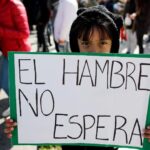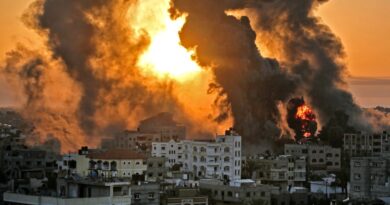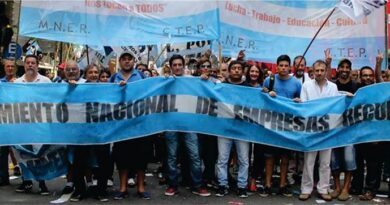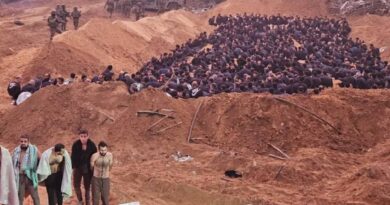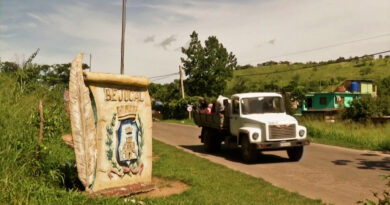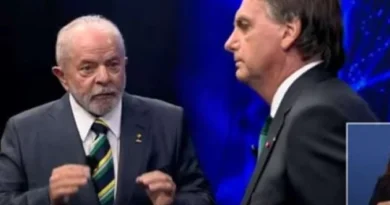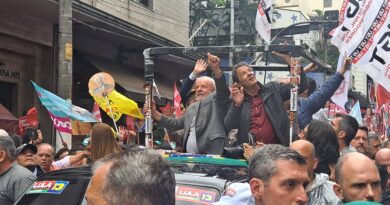The original peoples of Argentina in search of reparation for the genocide
CECILIA VALDEZ
The trials against humanity for the crimes perpetrated during the last Argentine military dictatorship created a precedent worldwide, but they have also laid the foundations for indigenous peoples to promote legal proceedings against the Argentine State for genocidal practices. Encouraged by the processes that have taken place in the last 40 years, different indigenous communities have undertaken their own processes of memory, truth and justice, with which they have already obtained two sentences in their favor.
At the moment, the Rincón Bomba Massacre (1947) and the Napalpí Massacre (1924) obtained favorable rulings and the San Antonio de Obligado (1887) and San Javier (1904) massacres are being investigated. In addition, legal complaints have been filed for the Desert Campaign (1878-1990) to be investigated and brought to trial.
FIRST SENTENCES OF THE ARGENTINE STATE
In July 2019, a ruling condemned the Argentine State for the Rincón Bomba Massacre (Formosa), considered crimes against humanity committed by the National Gendarmerie against the Pilagá indigenous people, and ordered reparations. Between October 10 and 30, 1947, the national security forces shot more than 400 Pilagás in the towns of Las Lomitas and Pozo del Tigre. The Massacre had the support of the Air Force, and Carlos Smachetti, the commander of the plane that machine-gunned dozens of people from the air, was prosecuted.
In the Trial for the Truth of the Napalpí Massacre, held in May 2022, a federal court held the Argentine State responsible for the massacre and demanded a series of reparatory measures.
"The massacre was a crime against humanity committed in the framework of a genocidal process against indigenous peoples," judge Zunilda Niremperger established in the sentence. In Napalpí, between 200 and 300 people from the Qom and Moqoit communities died, after a shootout with which 130 police, gendarmes and paramilitaries repressed a community protest. Their bodies were burned and buried in common graves. Their history denied or misrepresented.
And in September 2020, the caciques Luis Pereyra and Rosa Pereyra, from the Qom communities, filed a complaint with a federal prosecutor for the San Antonio de Obligado Massacre (1887), qualifying it as a crime against humanity and genocide. If this process goes ahead, it would be the first trial for the truth about an event from the XNUMXth century.
Until now, the official version of the massacre indicated that the indigenous people had killed the priest Ermete Constanzi and were killed in reprisal, but recent investigations show that the story was different.
In 1887, Rudecindo Roca, then governor of Misiones, sent to ask for a "china" from a community, for which a girl was taken by force, which caused general outrage. The Indians ambushed the soldiers as they returned to the community, prompting Roca's brother, the owner of a sugar mill, to send a group of cavalry to the reduction (forced concentration of indigenous populations) of Santa Ana, which ended up causing the Butcher shop.
What the investigators found in the records of Friar Ermete Constanzi -an Italian priest who had been summoned to "Christianize" the indigenous people- is the opposite of what had been said up to then and which had served to justify the massacre. In the minutes that detail the events, the friar defends the "innocence" of "his" Indians before the Ministry of the Interior and the press. Ten years later, he is assassinated for continuing to defend the communities. Exactly the opposite of the official version, according to the investigations carried out, which served to build the case.
In December of last year, the indigenous communities of San Javier and the Human Rights Secretariat of the province of Santa Fé filed a complaint with the federal prosecutor's office requesting the opening of an investigation for the Right to the Truth into the events of April 21. of 1904, in that locality.
"We come for this act to formulate a CRIMINAL COMPLAINT, for the persecution, repression and killing of members of the Moqoit people, all crimes against humanity in the framework of the genocide against the native peoples, carried out in different parts of our country during the formation of the Argentine National State”, argues the complaint.
And he adds that they consider this investigation, more than a hundred years after the events, "essential for the legal truth to reflect the historical truth, which has been transmitted orally in our communities, from generation to generation."
In San Javier, at the beginning of the XNUMXth century, a hundred Moqoit people died and many others were injured. According to the official version, it was a raid (surprise attack by indigenous people) that was repelled. The oral history of the indigenous speaks of mass graves and burials of people alive.
In August of last year, the Mapuche-Tehuelche referent Ivana Huenelaf filed a complaint before the courts to investigate the persecution and killing of indigenous peoples of Patagonia as genocide during the military expeditions known as the "Desert Campaign" (1878- 1890).
The configuration of the Nation-State, with the end of the colony, raised the need to impose its sovereignty over the autonomous indigenous regions. It is estimated that in the so-called "Conquest of the Desert" about 14 Mapuches were killed or taken prisoner. The Reform of the National Constitution in 1994, recognized the ethnic and cultural pre-existence of the Argentine indigenous peoples.
THE PRECEDENT OF TRIALS FOR THE TRUTH
The Truth Trials were a judicial procedure, without criminal effects, that were carried out for 18 years in Argentina, given the impossibility of criminally prosecuting those responsible for crimes against humanity of the last dictatorship, given the impunity that they were guaranteed the laws of Due Obedience, Full Stop and Pardon.
They are the result of the struggle of human rights organizations, which sought alternative strategies to deal with impunity, through the judicial search for the truth. Over the years, with the impunity laws annulled, criminal cases arose that charged those responsible for State terrorism, for which the evidence presented in the Truth Trials was taken into account.
In the case of the indigenous people, the Trials for the Truth seek to bring "historical and symbolic reparation" to the original Argentine peoples who were repressed, persecuted, hunted, murdered and denied.
In the absence of those responsible alive, these trials become the appropriate means to guarantee the rights to the truth, comprehensive reparation and non-repetition. This is understood by, among others, Diego Vigay, ad hoc federal prosecutor, who led the preliminary investigation and participated in the trial of the Napalpí Massacre on behalf of the Public Prosecutor's Office.
Vigay explained to DiarioAR that they took as precedents both "the process of prosecuting crimes against humanity of the last civic-military dictatorship, which has more than 1.100 convicted and which is considered avant-garde worldwide", as well as the truth trials held in the '90s in different jurisdictions of the country.
“We understood that, beyond civil lawsuits where federal prosecutors do not intervene, it was essential to carry out an oral and public trial, because the commitment assumed in judging crimes against humanity must cover all those that occurred in the course of the national history, not only those of the last dictatorship,” said Vigay.
In his opinion, The importance of these trials is that they make it possible to underline that genocidal practices did not end with the formation of the national State "but rather continued in massacres of the XNUMXth century such as the Napalpí and La Bomba massacres, two cases that occurred in democratic governments."
For sociologist Marcelo Musante, member of the Network of Investigators on Genocide and witness in the Trial for the Truth of the Napalpí Massacre, thinking that these trials are indebted to the post-dictatorship processes carries risks.
“One would have to be careful that saying this does not imply taking out the entire indigenous agenda, and the power that exists on the part of the communities for having sustained the demands, especially the oral memory recounting the massacres from generation to generation. Here the central thing is the word genocide, which allows us to think of a long-term, planned, systematized process ”, she indicates.
“FIRST AND SECOND GENOCIDES”
Paula Alvarado Mamani is a lawyer for the Pilagá Federation and a Kolla activist who participated in the complaint in the Rincón Bomba Massacre trial.
“We, the indigenous people, believe that there are first and second generation citizens. People excluded from certain systems, that is, indigenous people and people in conditions of vulnerability, belong to another type of social, economic and cultural class, thought from below”, she assures.
And he emphasizes that this is where the thesis comes from “that there are first-class and second-class genocides, second-class genocides are not claimed, they are not counted and, worse still, they are made invisible. So, these trials have to do with historical state reparation, but there is still a long way to go. Many human rights organizations do not embrace the indigenous issue either, because there are other factors at play, the class factor or the racist factor, to go no further.”
Alvarado Mamani maintains that this was seen very clearly with the deaths of Santiago Maldonado and Rafael Nahuel, two young men who were assassinated for defending the Mapuche cause. While the mobilizations and protests, in the case of Maldonado -a young middle class-, were massive, those of Nahuel -a young Mapuche- were not to the same extent.
The first cause of indigenous peoples against the national State was that of the Rincón Bomba Massacre in June 2005, for which a sentence had to wait 14 years.
"We are talking about cases that the State kept in a drawer (delaying its resolution) for 15 years," says Musante and points out that one cannot speak of the State "as something monolithic" either, since these cases involve not only the Executive branch on duty but also to the Judiciary.
“The first responses given by the Treasury Attorney regarding the Rincón Bomba and Napalpí Massacres, is to deny the communities as ethnic groups, they assured that neither the Pilagá nor the Qom are Argentine ethnic groups. So, if the Qom are not an ethnic group, they cannot sue the State for genocide. In addition, they argued that the massacre was not such and that "only" four people died in a confrontation. In other words, the word confrontation appears that does have to do with the last dictatorship. But what there is here is a denial of ethnic identity, which is why I believe that this 15-year process through which this was achieved is very important, and the value of all these positive sentences that are being given”, highlights the sociologist.
THE VALUE OF INDIGENOUS ORAL HISTORY
Melitona Enrique was one of the last survivors of the Napalpí Massacre. She was 107 years old when she died in 2008 without knowing that, 14 years later, something of that historical reparation for which she fought all her life was going to come true. Ella melitona did not personally declare before the prosecutors the events that she experienced when she was barely a child, but she kept them alive in her memory (hers and that of the other members of the community) through tradition oral.
Sabino is the youngest of Melitona's 12 children, the only one left alive and who contributed his mother's experiences to the Prosecutor's Office.
"She always told that they (the community) were already in that place before the Napalpí Indians were reduced, that her parents worked hard, but they were paid very little and they began to complain," says Sabino, who recalls that His mother spoke little because it made her very sad: "She told it in Qom because she didn't speak Spanish and I translated for her."
"It must not be forgotten that the survivors and the members of the communities live very far from where the trials take place, precisely because they were executed in the massacres,” warns Musante and points out that the trials, in addition, “They are not thought interculturally, with which, not only do they have to approach to testify, but they have to do it in a language such as legal, which is extremely foreign to them”.
The reconstruction of what happened in the massacres was achieved, fundamentally, with the testimony of the survivors and their descendants, but the work of archivists, sociologists, historians and anthropologists, who provided evidence, was also essential.
“This served to support or endorse the oral history that the communities had been supporting. In some way, it is a recognition because it seems that this oral memory is worth less than the documents, and it always remains as underhanded, as second-rate”, Musante highlights.
Alvarado Mamani trusts that over time this will serve to demonstrate a historical truth that can affect society as a whole, not just communities, and to prevent things that still happen.
For Musante, "the oral transmission from generation to generation also implied a cost, that is, it allowed a trial to be reached now, and that memory has been maintained, but it had a very high cost, which was the terror that it generated ”.
The Polish lawyer Raphael Lemkin, who coined the concept of genocide, argued that it is a process of destruction that seeks to transform the identity of a people through the annihilation of part of the population. Another of the objectives of the massacres is to install fear, which functions as a disciplinarian.
"It's about showing other communities what can happen to you if you protest," in the words of the Argentine sociologist.




